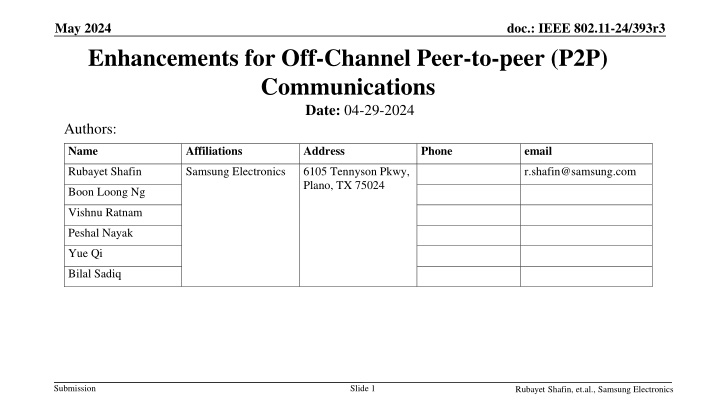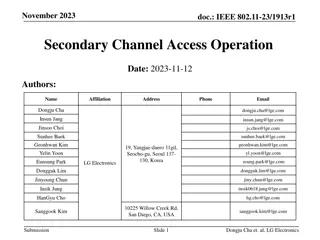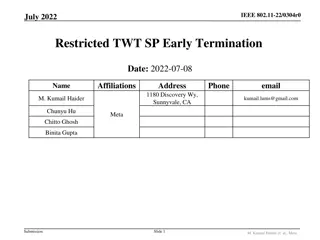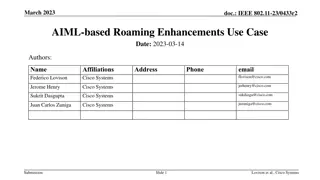Enhancements for Off-Channel Peer-to-peer Communications in IEEE 802.11-24/393r3
This contribution discusses enhancements for Off-Channel Peer-to-peer (P2P) communications in IEEE 802.11-24/393r3, building upon prior work in this area. It explores the concept of recommended P2P channels and how APs can incentivize P2P STAs to use these channels for better communication quality. The need for extended support in network topologies coexisting with P2P groups is also highlighted. Overall, the focus is on optimizing P2P communication within wireless networks.
Download Presentation

Please find below an Image/Link to download the presentation.
The content on the website is provided AS IS for your information and personal use only. It may not be sold, licensed, or shared on other websites without obtaining consent from the author.If you encounter any issues during the download, it is possible that the publisher has removed the file from their server.
You are allowed to download the files provided on this website for personal or commercial use, subject to the condition that they are used lawfully. All files are the property of their respective owners.
The content on the website is provided AS IS for your information and personal use only. It may not be sold, licensed, or shared on other websites without obtaining consent from the author.
E N D
Presentation Transcript
May 2024 doc.: IEEE 802.11-24/393r3 Enhancements for Off-Channel Peer-to-peer (P2P) Communications Date: 04-29-2024 Authors: Name Affiliations Address Phone email Rubayet Shafin Samsung Electronics 6105 Tennyson Pkwy, Plano, TX 75024 r.shafin@samsung.com Boon Loong Ng Vishnu Ratnam Peshal Nayak Yue Qi Bilal Sadiq Submission Slide 1 Rubayet Shafin, et.al., Samsung Electronics
May 2024 doc.: IEEE 802.11-24/393r3 Abstract In this contribution, we follow up on the prior work on enhancing Off- Channel P2P (OCP) communication [1, 2]. Submission Slide 2 Rubayet Shafin, et.al., Samsung Electronics
September 2023 doc.: IEEE 802.11-24/393r3 Background--Advertisement of Recommended P2P Channels Based on the recent addition to 11be, an AP can announce a set of channels in its BSS that are recommended for P2P communications These advertised channels would be more conducive to P2P communication. For example, the AP can minimize the use of those channels for its infrastructure communication. The AP can announce/advertise the Recommended P2P Channels in its BSS by including the related information in the Beacons and Probe Response frames it transmits. The AP can include Channel Usage elements for this advertisement The P2P channel recommendation can be updated over time. Motivation for the AP: By incentivizing the P2P STAs to keep their P2P transmissions within the recommended set of channels, the AP can essentially reduce the uncontrolled P2P transmission on the channels that the AP uses for infrastructure BSS operation (for UL/DL communication, for example) This, in essence, can help the AP in ensuring infrastructure STAs QoS requirements. Motivation for the P2P STAs: The guidance from the AP would enable the P2P STAs to embark on a cleaner channel (with less interference from the infrastructure) faster for their P2P communications by using the recommended channels Help faster setup of a P2P link (or P2P group) or faster switch of a P2P operating channel Submission Slide 3 Rubayet Shafin, Samsung Research America
May 2024 doc.: IEEE 802.11-24/393r3 Need for Extended Support (1/2) A typical network topology coexisting with P2P STAs/P2P groups AP1 AP2 BSS2 BSS1 P2P Group/Cluster STA associated with AP1 (cyan color) Unassociated STA in the P2P group STA associated with AP2 (yellow color) P2P STA associated with AP1 (dashed line) P2P STA associated with AP2 (dashed line) Submission Slide 4 Rubayet Shafin, et.al., Samsung Electronics
September 2023 doc.: IEEE 802.11-24/393r3 Need for extended support (2/2) The P2P STAs can follow the P2P channel resource recommendation from the AP for their P2P needs. AP2 AP1 STA1 This helps in parking on a channel for P2P that would have less interference from the BSS maintained by that AP (this would be off- channel w.r.t. that AP s BSS operation). P2P STA4 STA3 STA2 BSS2 BSS1 The P2P link between STA1 and STA2 follows the channel recommendation from AP1 but still suffers from interference from BSS2. However, in an OBSS environment, the P2P link is still likely to face interference from the OBSS network P2P channel recommendation from the first AP may be independent of the recommendation from the OBSS AP. Submission Slide 5 Rubayet Shafin, Samsung Research America
September 2023 doc.: IEEE 802.11-24/393r3 Multi-AP Coordination for Off-Channel P2P In OBSS environment, P2P group operation can be quite challenging When trying to go off-channel, it can be very hard to find a common off-channel that is clean from both infrastructure networks. AP2 AP1 For efficient P2P communication, it would be very beneficial if the APs corresponding to the overlapping BSS coordinate with each other. Upon coordination-- For instance, the APs can designate a common set of channels for P2P Help facilitate off-channel P2P operation STA1 P2P STA4 STA3 STA2 BSS2 BSS1 The APs can create a common schedule for P2P Help facilitate base-channel P2P operation Submission Slide 6 Rubayet Shafin, Samsung Research America
September 2023 doc.: IEEE 802.11-24/393r3 Time + Channel Info (1/2) The APs that intend to participate in off-channel P2P should strive to find a common channel where all the participating APs minimize infrastructure operation. In a congested environment, finding such a channel that would be clean (i.e. without infra-interference) for the entirety of time might be difficult. During the negotiation between the APs, along with the indication of a set of channels, the APs can indicate a set of time windows within each channel that the corresponding AP deems to be available for P2P. P2P Usage availability P2P Usage availability AP1 Exchange of information on P2P usage availability indication for a given channel. The overlapping portion can be announced in the respective BSSs for the off-channel P2P (OCP) window for that channel. P2P Usage availability P2P Usage availability AP2 P2P Usage availability P2P Usage availability AP3 Overall OCP availability Submission Slide 7 Rubayet Shafin, Samsung Research America
September 2023 doc.: IEEE 802.11-24/393r3 Time + Channel Info (2/2) Based on the information exchange/negotiation among the MAP participating APs, the APs can agree on a set of time windows for a set of Off-Channel P2P (OCP) channels during which the APs would minimize the infra operation over those channels. [Each AP can ahead of time optionally collect from the respective BSS s STAs the OCP traffic requirements] Upon successful MAP negotiation for deciding OCP channels, the APs can advertise these (time + channel) information in the respective BSS. Such timing information, together with the channel info, would be very valuable for deciding the availability windows for P2P group operation. For instance, the P2P group availability windows can coincide with the OCP windows offered by the APs. Conducive for P2P Conducive for P2P Ch. A Conducive for P2P Conducive for P2P Ch. B Conducive for P2P Conducive for P2P Ch. C Submission Slide 8 Rubayet Shafin, Samsung Research America
September 2023 doc.: IEEE 802.11-24/393r3 MAP Coordination Framework for OCP Multicast Multicast MAP coordination for OCP can fit in the general MAP framework AP1 AP2 Reject C-OCP The APs can go over the announcement process to discover the APs interested in OCP AP3 Accept C-OCP Alternate C-OCP The APs can exchange explicit frames to negotiate on the OCP parameters (e.g. info on channel and time windows) AP4 Accept C-OCP Accept C-OCP C-OCP Response frame C-OCP Request frame Submission Slide 9 Rubayet Shafin, Samsung Research America
May 2024 doc.: IEEE 802.11-24/393r3 Summary Efficiently finding a suitable off-channel is important for P2P STAs In order to ensure that the P2P off-channels also have minimum OBSS interference, the APs in the overlapping BSSs need a mechanism to coordinate with each other and jointly come up with a set of channels for off-channel P2P (OCP) operation. Such channels are deemed to be more conducive to P2P operation. For efficient OCP operation, information on a set of time windows for a given OCP channel would also be helpful for P2P clients. Submission Slide 10 Rubayet Shafin, et.al., Samsung Electronics
May 2024 doc.: IEEE 802.11-24/393r3 References [1] Rubayet Shafin et al., Follow-up on peer-to-peer (P2P) communication for UHR , 23/1424r0, Sept 2023. [2] Rubayet Shafin et al., Channel Usage Enhancements for P2P in UHR , 23/294, May 2023 Submission Slide 11 Rubayet Shafin, et.al., Samsung Electronics
May 2024 doc.: IEEE 802.11-24/393r3 SP1 - Do you agree to define a mechanism in 802.11bn that would allow multiple APs to coordinate with each other to find a set of channels and time windows that would be conducive to peer-to-peer communication? Submission Slide 12 Rubayet Shafin, et.al., Samsung Electronics























